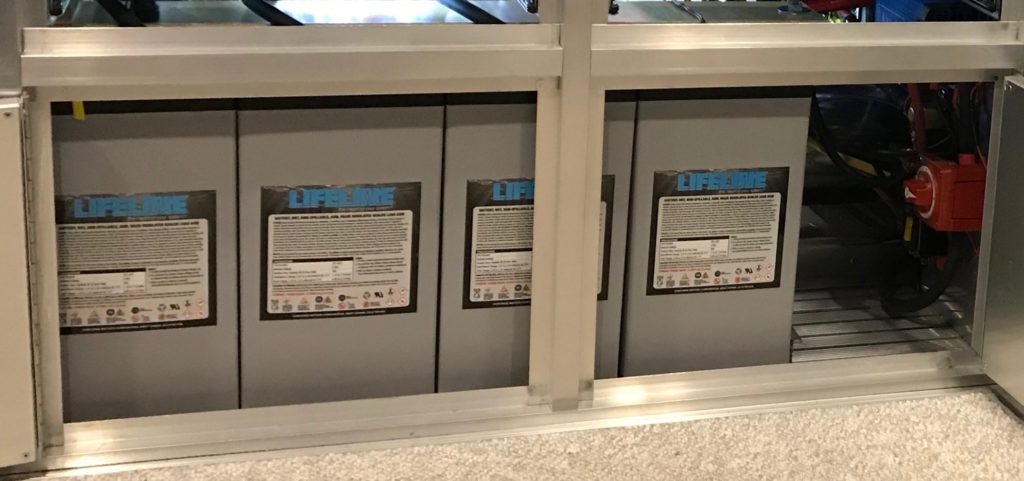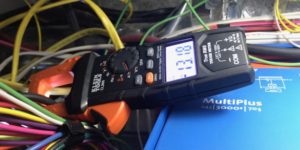Most people I meet boondocking are happy with two Golf Cart (GC) batteries and higher energy consumers will use Four GC Batteries. Here is an article helping you connect your batteries correctly.

So you want to boondock in your RV, and now you want to make sure the lights are always on. There are way too many different types and sizes of battery solutions for the dealer or manufacturer to install the battery that works best for you, so now it is time for a little homework. This article is directed at Flooded and AGM style of batteries. Refer to Is Lithium batteries right for my RV? for Lithium solutions.
 I started out by measuring the amount of DC (Direct Current) that my 2018 ATC toyhauler consumes withy my Klein clamp meter.
I started out by measuring the amount of DC (Direct Current) that my 2018 ATC toyhauler consumes withy my Klein clamp meter.
| ATC 28′ FB 2018 | |||
| 12v Amps | Hours run | Total Amps | |
| Trace Current | 0.2 | 24 | 4.8 |
| Garage Lights – 6 | 2 | 3 | 6 |
| Kitchen Lights – 4 | 1.3 | 5 | 6.5 |
| Entry Light – 1 | 0.3 | 1 | 0.3 |
| Bedroom Light – 2 | 0.6 | 1.5 | 0.9 |
| MaxxAir fan Level 1 | 0.1 | 4 | 0.4 |
| MaxxAir fan Level 5 | 0.7 | 8 | 5.6 |
| MaxxAir fan Level 10 | 3.2 | 2 | 6.4 |
| Water Pump | 6 | 0.75 | 4.5 |
| Furnace Blower | 7 | 2 | 14 |
| Awning Led Light | 1.1 | 5 | 5.5 |
| 12 volt Fridge * | 5.3 | 10 | 53 |
| Water Line Heater | ~3 | ||
| Fresh Tank Heater | ~10 | ||
| Gray or Black Heater | ~5 each | ||
| Total AH per day | 107.9 |
Explanation of chart:
The trace currents could be propane gas detectors, a propane fridge (needs 12v to operate), thermostats or other devices that may have been installed. I would expect this exact current to be a moving target and be different on every RV. The number after the lights are the number of LED bulbs/pucks on each circuit, each bulb/puck seems to consume .3A. I have a 12 volt fridge, it is aftermarket. Stock (from the dealer/manufacturer) is AC/ propane, which actually needs 12 volt to know when to cool. The heaters are on my “3 season package” and the actual amperage used seems to vary and will depend on ambient temperature.
Kudos to you if you’re still reading! Using the above chart, I use 108AH (amp hours) on a typical day. Since battery manufactures of Flooded or AGM batteries will recommend you do not use more than 50% – 80% of their AH capacity to achieve 300 – 1200 cycles in a lab (how far to discharge your battery). I should look at 216AH of battery bank. This chart is for Lifeline AGM batteries which test better than most. It is more common to get published lab results of 300 – 700 cycles at 50% Depth of Discharge (DOD).
I hope you have pulled out a calculator and are adding up your own expected usage. The next step is to decide how many days you want to boondock without any other sources of power. If my goal is two days I will want 432AH in my battery bank and so on. There is a lot of thought that can go into this part. How many lights do you want to have on at once? Does your spouse really NEED heat? Can you open the windows or doors to get a nice breeze instead of using the MaxxAir fans?
Some of you will be best served to use the battery bank that you currently have and see how long they last. At that point it might be easier to decide what solution looks better for you. Many people still use generators 2-4 days a week when boondocking, this helps people get by with less battery. You can add solar to the roof of your RV and if connect ground solar panels, they are easy to tilt and track for maximum sun harvesting. How much Solar do I need for my RV?
When purchasing the battery, it is important to pick the right battery for you. The GC and industrial (floor scrubbers type) across the board of manufactures is a higher quality battery (Thicker Lead Plates) than the automotive size (group24-27-31). When you look at top tier batteries like Crown, Trojan, Rolls and Lifeline they have a line of batteries that are built as good or better than the GC batteries. I prefer Lifeline as ALL of their batteries are built to this higher standard, it is easy to find their technical data (for setting up proper charging) on their website and they have answered all of my questions!